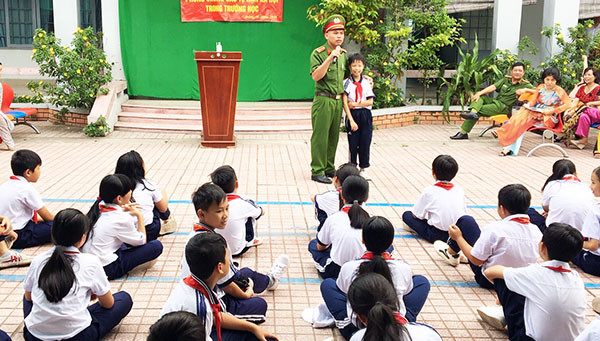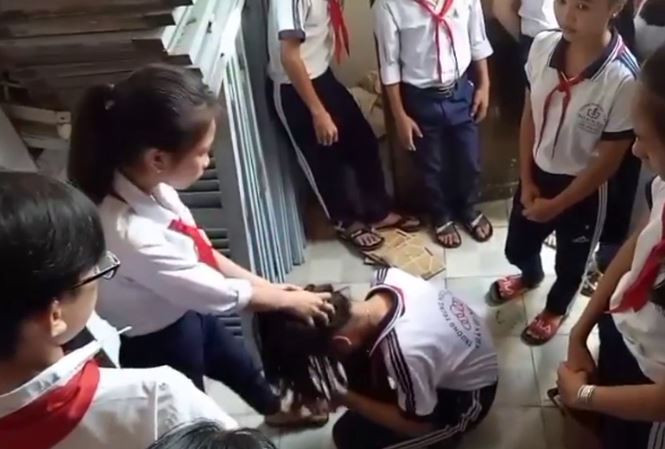
How many times did you fight when you were in school? Do not say no. I don’t believe it. I am used to be considered a kind of „people of the family,“ did well from child to adulthood, all day in school and other exams, the school, and the local, teachers and parents approved the report regularly with the word „good,“ the reward, the certificate of merit were like squeezed pictures and almost default.
But for all the popular games of students like fighting, racing, skipping school, etc. I am not a new mat. Only that my parents and teachers did not know that.
But perhaps the discomfort of our students in our time and as you are the parents of the students now, it is a lovely sassy.
We also dragged our friends to form fractions to talk and beat those fellows we dislike. Our fractions had leaders and we also built up the prestige of our teams but not to the point that using guns to block ways of others to kill a certain unloved classmate.
Also, the leaders of the groups were often also the best and smartest learners. They became wise earlier than their age, so the way they treated their friends was also more generous and tolerant than the other kids.
Maybe because in addition to studying together at the same school, we also lived close to each other, the family can walk to the other’s houses, parents often knew each other, many families were also colleagues or relatives.
So it was possible to fight during the day, and in the afternoon, the mother of two opponents would send one of them to the other’s house to carry a bucket of pig water, or ask for some errands.
It could also be because the prestige of the school and the teachers at that time was too big for the students – any stubborn kids in my neighborhood, whether they never went to school or had quit school early, bowed their heads and said “hi” when they met the elementary school principal.
While every parent was busy making a living, and they gave their children to the school, but most of all, they listened to the teachers. Parents meeting twice a year, every child being complained of by his teacher would be beaten by his parents.
Maybe because the media at that time mostly only praised the positive examples of studying, working, and behaved well. On the radio, acts that are considered harmful to the community (such as smuggling, greed of the public …) were subjects to social condemnation. In the community, they were given their names and judged for their morality. On the radio, they were painted, mocked, and even criticized so harshly they were almost boycotted.
On the other hand, larger and powerful offenders were hidden in the internal proceedings.
Such an environment creates a feeling that the vast majority of people were kind and gentle. If anyone dares not to be good, it is an extremely rare black sheep amidst the vast snow-white sheep.
Perhaps because of that, even lame or violent behavior was invisible to the extent that it did not become a crime.
In my house, there was an old guy named L. When he was a child, he was famous for his mischief, leading a group of teenage boys. Later, my family moved to another place quite far. Several decades after casually asking about old neighbors, I realized that at the age of 17, he acted like a robber, then became a big gangster, and was taken to prison. It was a troubled period of transferring between a central-planned economy and „reform“ in a fierce and unrepaired way. But in the old areas, he was still Mr. L.’s big brother, gangster, not going to bully dirty, beat and kill classmates or people living in the subdivision.
Then why, a few decades later, the economy and culture of Vietnam have grown dramatically compared to the old period, so many student fights are so widespread and extreme that they become carrying knives and killing people?
Just last April, a group of 5th graders in Nghe An (they were 11 years old) played soccer. One kid kicked a ball and hit another’s phone, and it broke. They quarreled. The next day, the kid with a broken phone brought a knife to school and stabbed the other kid straight away.
A year earlier, also in Nghe An, just because reading the name of a character in the game differently, two 16-year-old boys also fought to the point one taking a knife to kill the other. One was in 10th grade just dropped out, the other in the 11th grade.

A horrible case in 2015: a 15-year-old male student killed a man after he was asked to have a gay sex, then the victim denied to pay him.
As for cases such as male students, female students slapping, tearing clothes of their fellows, forcing their victims to knee, filming and posting pictures online … you can find them very easily because these incidents are too many.
Young thugs come from very different backgrounds. They may have rich, middle-class, well-fed or poor parents. They live in cities or remote mountains. They can be planned ahead or take action temporarily. But almost all of them have something in common: immaturity in the mind, but extremely high ego. In many cases of student violence, most of the time it is because they feel underestimated, looked down on, or ridiculed, making their ego hurt.
In cases of female student violence, the main reason is mostly from the fact that their „lover“ or even their „dream person“ suddenly does not care about them but turns to other fellows, making the culprit feel inferior. Violence is a way for them to protect and assert themselves.
It is a common age psychological phenomenon. Educators will know how to increase education in understanding and modifying behavior for this same age group and those who regularly approach them.
But there are non-subjective reasons. That is the current state of society and social media.
How strange, but very easy to understand with the mentality of adolescents is very attracted to the disruptive and rebellious things: just recently, one of the idols of many Vietnamese women is Khá Bảnh (Quite Cool). The ugly and weird haircut guy, dropped out of grade 7, he was arrested for injuring others and gambling, even though he claimed to be a carpenter.
But on the Youtube channel that used to have nearly two million followers, Khá Bảnh often uploads videos with bold morality like brothers who have to live and die together, one person is humiliated, his crowd attacks the opponent. With his fellows, he was throwing his money without counting. Well, you have to see the crowd of uniformed students screaming Khá Bảnh and jostling each other to take pictures with him. Or the scene of Khá Bảnh smiling and waving when being escorted to the prison.
A few years ago, a clear-faced clip of a “princeling” of a big private banker watching juniors undress a girl who was tricked into being drunk and later rapped spread very strongly online. Then just like how it came to be, the clip suddenly went silent and disappeared completely online. But everyone understands that in order to drown out that killing and criminal case, the banker had to spend a big sum of money.
Similar examples have been found on Vietnamese social media and newspapers. In fact, bureaucrats, their children, and the children of the wealthy can use money and power to blatantly defy the law and social morality. It spawned a new phrase of Vietnamese people still popular today, „Having money (then) has the right.“ Money is power.
A society was stunned and dictated by money, exposing endless gaps between people with money and those who don’t, and also deprives many parents of their time and care for their children. Many people plunge into a living or get rich, leave their children’s education to the school, just knowing their children still go to school in the morning and return home in the afternoon. But unlike before, they also no longer respect schools.
The social environment is seriously poisoned. Not only affects the general perception of students‘ ages, but they also kill the respect of a profession once called the highest. In the past, although the teacher was nearly starving to death, still tried to maintain the same level of standards as teacher Thu in writer Nam Cao’s story, now, along with the turmoil of making money in society in general, many „teachers“ revealed themselves the poorest meaning of the word. Teachers who engage in love, seduce students, cheat, buy certificates, ignorant, dirty, etc. all have.
Illuminated by such countless mirrors on a daily basis, while so little positive and correct information is present (sadly, righteous positive people are often not rich, humble, and do not use the trick of attraction. public opinion), too lack of guidance and discipline from home, school to religion, ideological children only need money or become strong, they can be inviolable.
Society in their eyes is a wild place, big fish bred small fish, the principle of operation is based on that the strong can win. Beating a weaker classmate, they instantly become strong. When picking up a knife to find a classmate who has just quarreled, they become strong.
The strong are untouchable. The strong get acclaimed, have money, and become an idol. Good people, kind and meek, are weak, bullied and lost. Any tricks are accepted, free of charge. Society has taught them that.
So ladies and gentlemen, let’s look wide. School violence is only a small and indispensable part of a society that is rotten with true values, the eternal values that make up human civilization. It is righteousness, integrity, honor and honesty.
To limit and hopefully address school violence, UNICEF Viet Nam has advocated to pass the Law on Children with punitive measures for violence against children. But the punishment is only a very small tip of the condition. The root is still rooting and crawling deep in consciousness for several generations.
Every day honesty, righteousness, honor and integrity are still considered the manifestations of the species listed in the Vietnam Red Book, three odd things like students carrying sticks to school to fight each other is still rampant.
Thoibao.de (Translated)


























